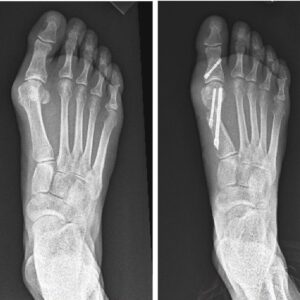Minimally Invasive Foot & Ankle Surgeries
Minimally Invasive Foot & Ankle Surgeries Are Maximizing Patient Outcomes
When it comes to orthopedic surgery, less is very often more. The less invasive the procedure, the more likely the patient is to have a faster recovery, less pain, less swelling, and a better overall outcome. That’s why Minimally Invasive Surgery (MIS) has been gaining popularity amongst foot and ankle surgeons and patients alike.
At the Reno Orthopedic Center, we’ve adopted these techniques and are seeing both excellent results and happier, more-mobile patients. Utilizing, small incisions and uniquely advanced instrumentation, MIS has become a particularly popular and effective way of addressing Hallux Valgus Deformity, better known as Bunions.
Bunion Procedures
Since switching to the MIS technique, I’ve seen great improvement with my bunion patients. We use a specially designed burr to make a chevron-shaped cut in the metatarsal head and then shift it laterally to narrow the foot and correct alignment. The head is then secured in its new position with two specifically engineer screws that hold it in place during healing. Often an additional cut is made with the MIS burr to the big toe, straightening it out, and securing it with a screw.
These procedures are accomplished with several very small incisions, rather than one or two large ones. We also typically avoid violating the joint capsule, which results in less scarring and stiffness. Immediate weight-bearing is allowed with a protective shoe which the patient typically wears for six to eight weeks, depending on how quickly their bone heals.

Before and after images of new MIS Bunion Correction
Bunionette
Bunionettes occur on the outside of the foot. MIS techniques for their treatment typically do not require stabilizing hardware. Rather, the prominent, pain-causing bone is moved to a more suitable location, and the toe is taped in a straight position for several weeks.
PROstep MIS Bunionette Animation Video
Other Procedures for Deformity Correction
MIS techniques can be employed for numerous other deformity-correcting procedures. These include Planovalgus (flatfeet), Cavovarus (high arches), Metatarsalgia (pain in the ball of the foot), Charcot (midfoot collapse experienced by diabetic patients), and many others. Often, these surgeries are performed in conjunction with other procedures such as tendon or ligament debridement or repairs that require multiple incisions. MIS can eliminate the need for some of these incisions, thereby making the operation safer and the recovery easier.
Please remember that every patient is unique, and MIS is not appropriate for every case.
Why Choose ROC?
Our foot and ankle doctors have extensive experience in treating foot bunions. Our physicians work in concert with other foot and ankle specialists including nurse practitioners, physician assistants, imaging specialists and orthotists to provide our patients with the best treatment plan that gets them back on their feet. To schedule a consultation or appointment, contact us.
